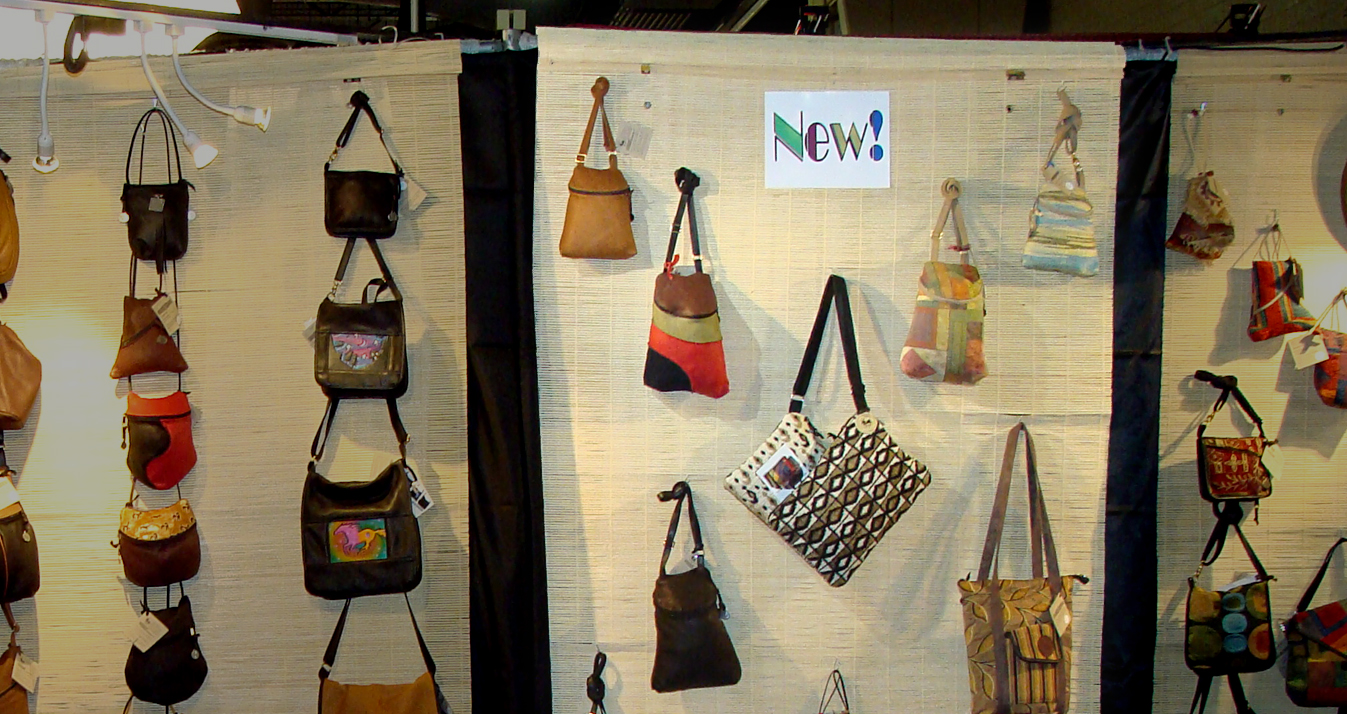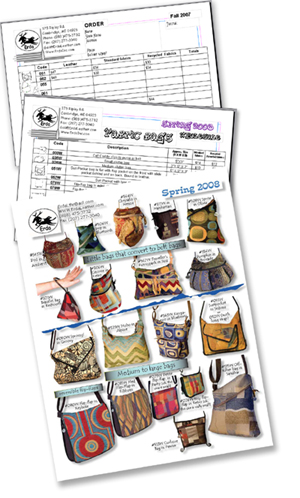The current economic situation has compounded a tendency I’ve noticed increasing at trade shows for several years: Buyers who used to write their whole season’s orders at shows now seem to be using shows to gather information for later ordering, or writing small sample orders. This gives them the option of synthesizing everything they’ve seen before committing their dollars, assuring that they bring in the best possible assortment and avoiding Buyer Remorse. It also allows them to try out a new product before investing too much of their limited cash.
What made me notice this trend originally? While my business’s annual sales have risen dramatically over the past five years, our sales written at shows have not: the increase has all come from reorders and orders from other sources. This year, the number of orders actually increased, while the total dollars written at the show decreased!
Lass King, Buyer for the Grasshopper Shop in Ellsworth, Maine, is typical of the buyers I interviewed. I thought maybe people were traveling to fewer shows, but she said she is still going. But, she said, “I’m not leaving any paper. Five or ten years ago, we’d just order whatever we liked, and figured we’d always sell it eventually. Now, we try to be more careful how we spend, so it’s better to bring the papers home to decide how to allocate our dollars.”
Woody Woodruff, of Loon Landing in Minocqua, Wis., also told me he goes to a lot of shows in winter, so he needs to synthesize and look at his inventory before deciding where to bestow his orders.
If this is the new reality, how do we adapt? How do we get the initial attention, and, ultimately, the orders and reorders? I break it into three steps:
1. Get them to actually stop and notice our work: Step away from your booth, and try to see it as a harried, distracted, overwhelmed buyer would. Is it clear exactly what you’re selling? Is there something about your work that differentiates it from all the rest? Can you tell from twenty feet away? If your works are small, or have intricate details not visible from twenty feet, you’ll need large graphics to cause potential buyers to consider stopping. Work needs to be arranged and lighted to emphasize the uniqueness your offering.

2. Give them a reason to look more closely, and make them feel safe and comfortable doing so: There must be enough different sizes, colors, shapes and prices. Imagine you’re the customer: Do you want to step over the boundary of a vendor’s booth, and commit the time and energy of interacting with the artisan, and possibly establishing a relationship? You’ll want to be able to see, from outside that boundary, that there’s an assortment of items that you’ll potentially purchase. Buyers don’t want to invest valuable show time to get just an item or two. Betsy Lenora, Gallery Manager at Cambridge Artist’s Cooperative in Cambridge, Mass., says, “There must be enough variety to stop us. I go right past if I see it’s all too expensive!”
Work must be organized so it’s visually easy to understand and order. Eileen Smith of the Handcraft House, in Brewster, Massachusetts, told me she only had a few hours to see the show, and appreciated that I respected the value of her time. “You showed me quickly what was new” (I had it all on one wall). She made notes on my catalog to make ordering later easy.
One of my reps told me about a line that he sells well. Buyers tell him they prefer to write orders with him, rather than the designer, because she keeps them in her booth forever, telling them her life story and that of the items they’re ordering. Many vendors think that the longer they keep a buyer in their booth, the more likely that they’ll order. In fact, the reverse is true. You don’t want to make people feel like they have gum on their shoe! They won’t come back next time.
3. Get them to buy, if not immediately, then later: Give ‘em something to take home! Ideally you want stores to order at the show. I encourage that by offering guaranteed sales, or giving my existing customers the opportunity to rotate stock, and sometimes offering to date their invoices later so they can get the product in earlier and have a bit more time to pay. I often mention other galleries they might know who have had success selling our products.
Ideally you want stores to order at the show. I encourage that by offering guaranteed sales, or giving my existing customers the opportunity to rotate stock, and sometimes offering to date their invoices later so they can get the product in earlier and have a bit more time to pay. I often mention other galleries they might know who have had success selling our products.
I use my best skills to differentiate us, so buyers will be motivated to order immediately, or will remember our products and order later. I am careful to tell our story, provide good materials to help the store to tell our story, and give the buyer some small item that will help us stand out in their memory. Last year, for example, I gave them luggage tags with Victorian ladies clutching an Erda bag. I explained that those ladies wouldn’t have looked so sour if they’d had one of our whimsical bags!
Getting an order after the show is easier if the customer has had some positive experience with your products. If they’ve not placed an opening order, how will they remember what attracted them to your wares? You must have stellar materials to enable ordering while not at the show: brochures, catalogs, and price sheets, and a comprehensive website. (I price my bags at triple keystone on the website, so we don’t compete with stores.) By providing these tools, I ensure that what orders I write at shows are only the tip of the iceberg, so to speak. Once, a couple years ago, I visited a customer’s gallery when she was struggling to order from my competitor’s catalog. I am  humbled to relate what she told me: that although she wanted their handbags, our catalog made it easier to order from us!
humbled to relate what she told me: that although she wanted their handbags, our catalog made it easier to order from us!
Lass King told me she often can’t remember, once she’s home, exactly what the products were that she wanted to order. Without a great color catalog, she often doesn’t follow through and order. Marcia Strenlau Of Handworks Gallery in Blue Hill, Maine, actually told me she finds she doesn’t need to see us at shows at all, because our catalog shows our current fabrics and styles so well (and she’s already familiar with our quality and customer service).
Because our offerings change so quickly, we can’t use a catalog that isn’t equally adjustable. (This freshness is key to keeping buyers interested). Last year, we bought a professional-quality color laser printer (to replace the $500 consumer version we had before), so instead of $2.50, our catalogs cost more like 40 cents. So now I can hand color sheets out with abandon, instead of hoarding them. This has also made it feasible to hire sales reps in new territories, since a few samples and plenty of catalogs works much better for them (less to carry) and for us (less expense).
Other current strategies
Speed up delivery! Under current circumstances, stores don’t want to risk ordering too much at a time, so they often find they have sold out and need products right away. Kathy Kaylor of Atlantis Leather in Frankford, West Virginia, told me that she really appreciates that she can order close to her needs. We always have a comprehensive inventory of our best sellers, so she can call, if she has an unexpected rush, and have stock in a day or two. She said she’s stopped ordering from vendors with long delivery times. She’s keeping her on-hand inventory “close to the bone”, she says. Many of my other buyers echoed this reality.
Stay positive! At the shows, and in general, it’s really important to maintain a positive attitude. Understanding that the tally of orders written at the show is not the whole story helps keep me upbeat. I overheard vendors this season saying that the show felt slow, that a lot of people were just looking and taking catalogs, the economy is killing us, and so on. Negative talk doesn’t help! Even if this is accurate, we need to address the issues in a positive fashion! If I heard it, so did buyers, and if they feel negative, they’re not going to place orders.
While of course there are some negative changes in our markets (too many shows for the number of buyers, some stores closing, shrinking buying power in the shrinking middle class) there are still plenty of opportunities out there if we stay alert, prepared, and optimistic.






